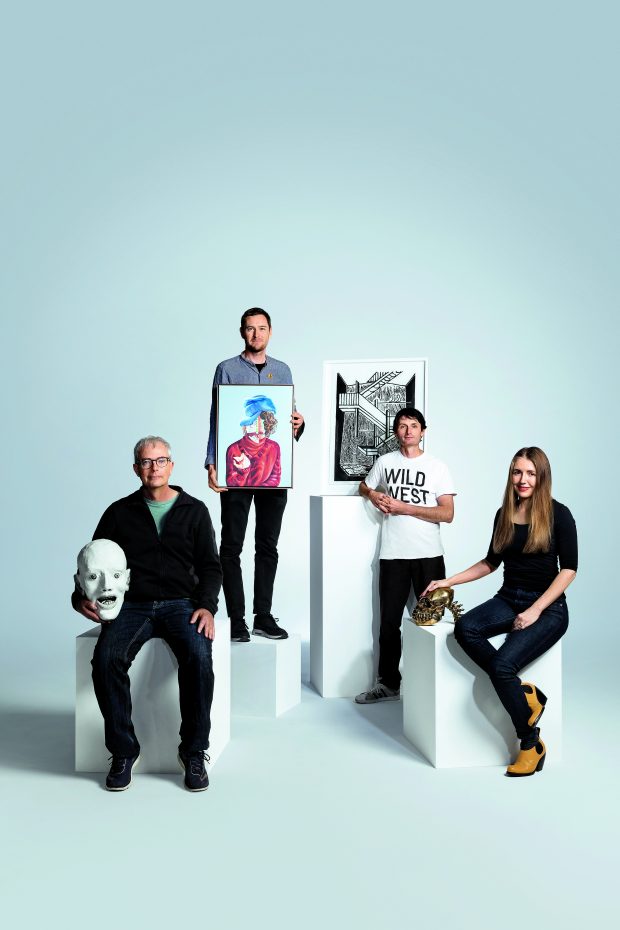Meet our fine artists
James Morrison (DipFineArt 1983, PGDipFineArt 1996).
Beginning work with papier mache some decades ago, James Morrison would use newspapers and cheap glue. He was astonished to find the sculpted newspaper disintegrate within a year. “It would turn to dust,” he recalls.
Consulting a paper conservator, he began to use a new formula of materials, but when Michael Buxton visited his studio he happened to admire work that had been done using the old newspaper method – so the artist issued a warning about its likely limited life span.
Later, using the more enduring techniques, Morrison’s work was acquired for the Buxton Collection. Among those on display at Buxton Contemporary’s inaugural exhibition The shape of things to come is a papier mache work depicting a hand meddling perilously with a scorpion. Sculpted with 500-year paper (as it is known in the industry) mixed with pure starch, it passes all the archival tests – and is an extraordinarily detailed work, its surface drawn upon with pen and ink by the artist.
Morrison, born in 1959, completed a Diploma of Fine Art and a Postgraduate Diploma (1990) at the VCA. He is committed to detail in his work, which includes the five-panel Freeman Dyson (2008), which tells a loose story of an astronaut finding himself on an Earth-like planet. “Michael appreciated getting into the narrative behind the work.”
Rob McHaffie (BFineArt 2002, GDipEd 2004)
Rob McHaffie recalls Michael Buxton making visits to look at his work when he had a studio at the Abbotsford Convent in 2010. He knew about the Buxton Collection because the work of some of his former colleagues at the Victorian College of the Arts, such as Nick Mangan and Ricky Swallow, had been acquired for it.
McHaffie knows the University well, having studied science and then engineering at Parkville before transferring to the VCA to do a Bachelor of Fine Arts (Drawing), graduating in 1999, and a Graduate Diploma in Teaching (Visual Art), completed in 2004.
When Mr Buxton visited, McHaffie presented his drawings and an extensive chat ensued.
“He chose things with such confidence,” McHaffie recalls. “I had never experienced that with a studio visitor before. He really backs his own choices, and that was positive feedback for me.”
Mr Buxton has continued his acquisitions, while also giving McHaffie a residency at his Portsea house.
“He is someone who is true to his word. Collectors [often] say they will follow your work, but often drop off; Michael keeps the relationship with the artist.”
During his career, showing his works through Darren Knight Gallery, McHaffie has often reflected on the great foundations he had in the drawing department, where tutors from various disciplines encouraged wider experiences, stretching beyond drawing to painting and installation work.
Benjamin Armstrong (BFineArt 1996)
Visitors to Buxton Contemporary are intrigued when they see other patrons peering into Benjamin Armstrong’s enormous oculus-like sculpture Into the Underworld (2007).
Unable to resist, they scoot across and peer into the opening of the round glass vessel with its waxy surface, and through the sides of which only a few blurred shapes can be seen. Inside are orbs that might be eyeballs or breasts, surrounded by what look like rotting apples. His work, often made in glass and wax, is said to move between the homely and the uncanny: it succeeds.
Armstrong (born 1975) holds a Bachelor of Fine Arts (painting) from the Victorian College of the Arts (1996) and says Into the Underworld was first shown in 2008 as part of a larger body of work. This piece was partly born out of his responses to reading The Road by Cormac McCarthy, while the linocut prints called The Shape of Things to Come II (2006-2007), also in the Buxton Collection, functioned “almost like an instruction manual” for some of his sculptures at the time.
On a round of studio visits, Michael Buxton was also intrigued by the works, eventually acquiring them. “It has been an ongoing connection and friendship,” Armstrong says.
Patricia Piccinini (BFineArt 1991, DVPA 2016)
Patricia Piccinini is one of Australia’s most celebrated contemporary artists, known here and internationally for her hyper-realistic sculptural and digital photographic work that explores concepts of what is ‘natural’ in our techno-centric age.
For all the squeamishness her incredibly detailed works might evoke in viewers, they retain a deeply personal edge that somehow deepens our connection with the often grotesque creatures she creates: entities with distinct human DNA are her forte.
Piccinini, who is having an extensive retrospective at Brisbane’s Gallery of Modern Art this year, is represented in all of Australia’s most significant collections. She holds a Bachelor of Arts in Economic History, Australian National University (1988), Bachelor of Arts in Painting from the Victorian College of the Arts (1991) and a Doctorate in Visual and Performing Arts from the University of Melbourne (2016), where she has also taught. Her exhibition history is extensive, and Michael Buxton has carefully followed her work for many years, buying several works between 2002 and 2007.
Piccinini has been described as being interested in the way the human form can be enhanced and manipulated through bio-tech intervention, from “mapping of the human genome to the growth of human tissue and organs from stem cells”, all of it raising serious questions about ethics, scientific progress and the delineations between what is human – and what is not.



